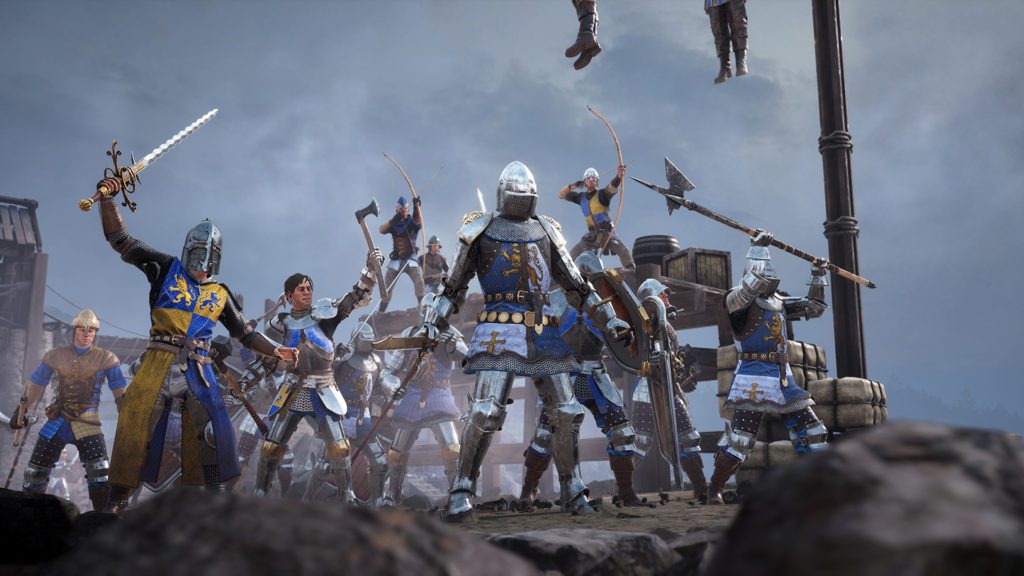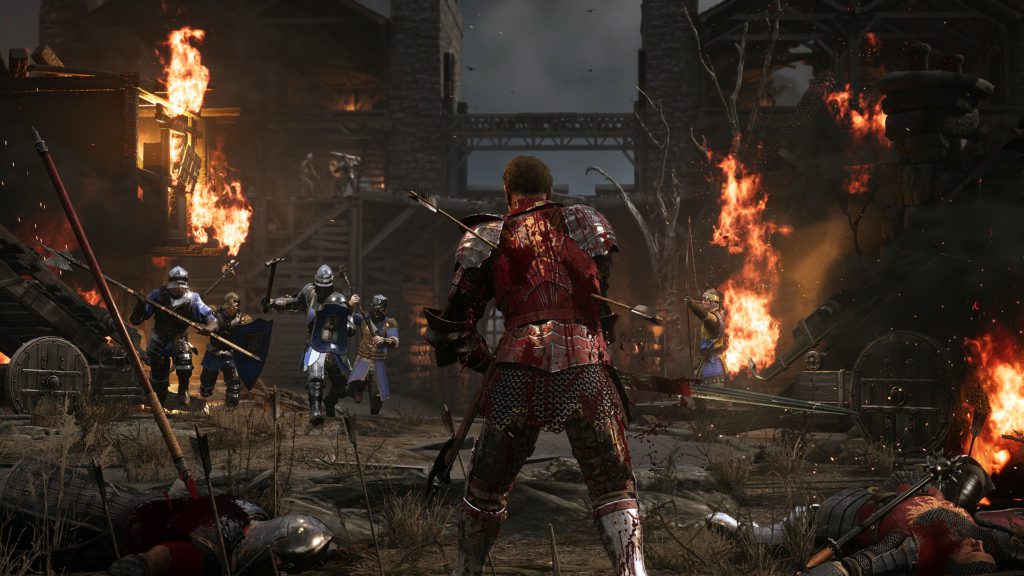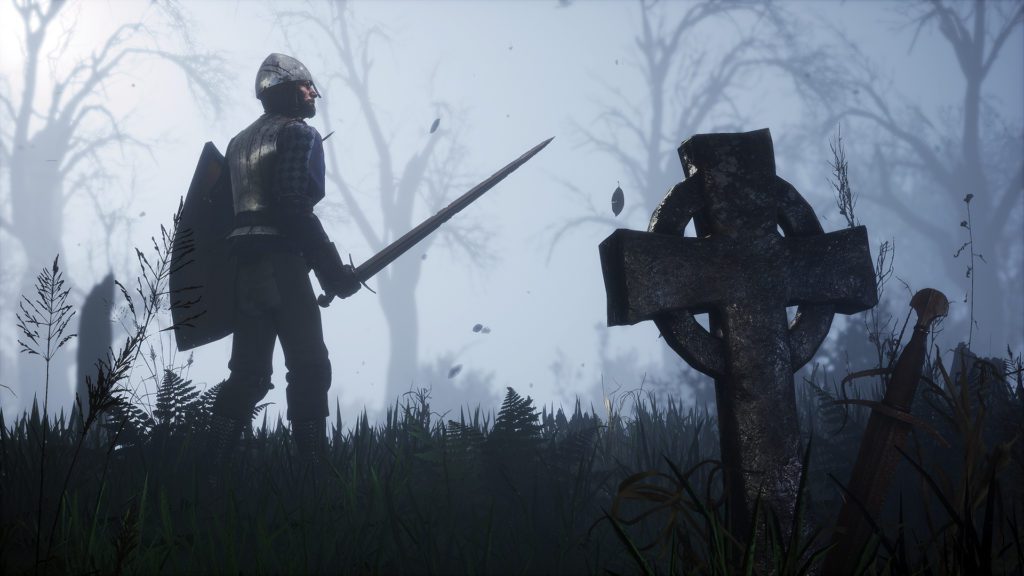What honour there is to be found in Chivalry is usually well hidden. Deep beneath the tides of war, duels are fought in seclusion between noble knights and virtuous swordsmen as the chaos of battle threatens to pass them by. For the victors, the prospect of another test of mettle will soon present itself—the rampaging swords and shields of the enemy aren’t so easily stemmed. For the defeated, the chance to live and die again within the throes of mayhem usually triumphs over any notion of honour. There are few limitations when it comes to conducting yourself on the battlefields of Chivalry 2, and there’s plenty of merit to be found in whatever way you choose to engage the enemy. With such a fulfilling freedom of expression afforded to every soldier, be they an axe-swinging crusader or a fleet-footed archer, the opportunities to accelerate the cycle of turmoil are endless and the chance to carve out your own five-minute legend is renewed with every charge into the fray.
Torn Banner’s Chivalry 2 is a medieval multiplayer slasher that pits two teams of up to 64 players against one another across deathmatch and objective game modes. There’s an obvious comparison to be made here between Chivalry and Ubisoft’s For Honor, but the similarities between the two games both begin and end at their focus on swordplay. Whereas For Honor employs strict class definitions, in Chivalry, classes are determined more by a player’s choice of weapon than by the special abilities integral to their chosen role. And as For Honor ferries its players into duel scenarios by utilising a much more compact scale of map design, Chivalry 2 harnesses grand open spaces and a much larger player count in order to stage its own ferocious brand of melee combat. Chivalry 2 eschews realism when it comes to the historical accuracy of its arms and armaments, but beneath that veil of fiction, where the honourable Knights of Agatha fight against the sinister Masonic Order, there’s a prevailing sincerity to the way in which soldiers do battle. When steel meets steel in Chivalry 2, you’ll be forgiven for clenching your teeth.
Initially, it’s a little difficult to navigate your way through all of the noise. While experience with the game better dictates your understanding of combat, weapons, and the limitations of both, the unpredictability and ruthlessness of the players that you come up against is what keeps things consistently entertaining. Successfully besting a single opponent is a fair marker of your progress. And multiplying that achievement over the course of a full-length match would suggest that those on the enemy team are likely getting tired of the sight of you. Knowing how to properly make use of your offensive repertoire then is the key to achieving glory on the battlefield. Attacking an enemy is as straightforward as choosing your preferred type of swing and anticipating a response, though there’s plenty of room for both players to manoeuvre as each vies for control of the engagement. In Chivalry 2, combat is free-form and unrestrictive. There’s nothing written in the rules of warfare to suggest that an opponent may attack only after you have, or that you can’t attack twice in a row. With only a few exceptions reserved for specific weapons and special attacks, every soldier operates using the very same set of moves and utilises them in a way that best suits their particular play-style. Even though there are finite ways to attack an opponent, mastery of the technical side of things isn’t imperative to your success—often, little other than sheer determination can be enough to will you to victory. What keeps things in Chivalry interesting is meeting another soldier on the battlefield who is significantly more proficient than you. Just as developing a deeper understanding of the game’s core systems may be what helps you edge to a future victory over a skilled opponent, so may a well-timed toss of a shield, or even a swift escape from battle altogether. There are no lesser accomplishments in Chivalry 2, and that’s exactly why every triumph feels just as important as the last.
FROM DEATHLY BELLOWS TO THE REVERBERATION OF COLLIDING STEEL, THE CACOPHONY OF SOUNDS EXPERTLY EMPHASISE THE FEROCITY OF WARFARE
With so much going on around you and death only ever a blink away, it’s practically impossible for a single player to dictate the flow of battle without any assistance from their allies. With one hand, Chivalry 2 goads you into trying, empowering you to face the most impossible of odds with the belief that victory is just a few perfect sword swings away. With the other hand, the game frequently reminds you of your fragile impermanence, forcing you to watch as your severed head rolls between your ankles, or gawk at your lifeless form as it’s pinned to a castle wall by a ballista bolt. Born of this duality is the lack of control that allows Chivalry 2 to remain so compelling. And that lack of control is exactly what makes any player, be they a seasoned veteran or fresh-faced conscript, pose an equal threat to your life. When you find yourself engaged in a breakaway duel, you’re certainly in charge of your own motions, but it’s not as if the rest of the battle ceases to exist simply because you’re focused on besting a single opponent. You’re the protagonist, at least from your own perspective, and as the would-be hero of your own little tale, you’ll duel with honour and skill until your challenger has been defeated. From the perspective of others, you’re little more than two lost soldiers blocking and parrying in an open field, and your fight to the death is just as likely to be interrupted by an axe to the back as it is a flying tankard of mead to the head.
Combat is certainly difficult to master, but it’s superbly approachable and a tremendous amount of fun. When it comes to offence, you can attack with overhead lunges, sweeping swings, precision jabs and colossal slams. Defensively, you can block, push, kick, evade or even flee from the conflict altogether. Everything that you do incurs a stamina cost, and as you begin to get to grips with combat, you’ll find that managing your stamina output becomes integral to your survival. If your stamina bar empties while blocking, then your weapon will shatter. And if you’re caught without the energy to defend yourself then death is sure to find you. The key is to generate stamina through a controlled and measured offence. Bridging together basic combat moves is an extra layer of responses that, when executed correctly, can pivot momentum right back in your favour. Matching an enemy’s swing with your own identical follow-up will trigger a counter, allowing you a window of opportunity to strike in response. Similarly, a well-timed block will turn into a parry, which can then be followed up with another attack in the form of a riposte. You can alter the angle of your attack mid-swing, target specific body parts that may be unguarded, and most impressively of all, prematurely cancel an attack in favour of another by performing a feint. The moment that you begin to passively incorporate each of these moves into your fights is when combat begins to make a lot more sense. After your decision making naturally becomes more reactive and efficient, you’ll never really need to fixate on the stamina bar again.
TEAMWORK FLOURISHES ON THE BATTLEFIELD. A SMALL, COHESIVE UNIT OF SOLDIERS CAN BE JUST AS DEVASTATING AS A FULLY CREWED CATAPULT
What issues I ran into during gameplay stemmed from server-side hit detection registration and general latency problems. Connection interruptions are frequent enough to be noticeable and I’ve been dropped from matches altogether on several occasions. And as an additional side-effect of playing as a squad of four, we’d regularly have to shuffle ourselves around just to ensure that we were all together on the same side. Matches in Chivalry 2 begin with a small cutscene to contextualise the upcoming battle, before the two teams meet each other head-on in the opening clash. In deathmatch, as in free-for-all, you win the round by reaching a specific number of enemy kills. In objective game modes meanwhile, the defending team have to hold back the attacking team until the game clock counts down to zero, all the while trying to prevent them from moving equipment into position, destroying key emplacements and killing specific targets. Despite the relatively small size of the map pool upon release, the array of different objectives, locations and design choices help in making each map feel largely distinct from the last. Objective maps are so large in fact that each of them is comprised of over half a dozen different unique combat arenas, all of which are tethered together to form a single linear map that gradually unravels as the attacking team pushes forward. In order to achieve that level of variety though, Torn Banner have been forced to make a few concessions when it comes to balance. Some scenarios just seem heavily weighted towards one side rather than the other. The final defence point of the Coxwell map immediately comes to mind, which sees the defending team spawn as peasant farmers and get fed to the slaughter for minutes on end. And there’s also the final stages of Falmire and Rudhelm which put the weight of the entire match on two specific player-controlled targets, with victory largely dependant on whether or not these chosen few decide to play cautiously or not. Much more egregious though is the inconsistent spawn locations, player desertion exploits, and the baffling decision to not initiate overtime when an objective is still active, meaning that the final 30 seconds of a match are often entirely pointless to engage with.
For a while, there wasn’t a problem in Chivalry 2 that I couldn’t fix by loading into another match and rejoining the chaos. Combat is the core of the experience, and it’s clear that the vast majority of Torn Banner’s development cycle has been spent on ensuring that it’s up to scratch. Unfortunately, the longer that you stare under the hood, the more that you’re unable to ignore the mess that lies within. In spending so much collective energy honing the game’s combat, Torn Banner have actively neglected many other aspects of the user experience. For one, the user interface is dreadfully unintuitive and the cursor tends to have a mind of its own. On one occasion, as the cursor lagged, I ended up dropping 20k of currency on an item completely by accident. On another, I loaded my team into the training mode multiple times in a row due to the fact that the cursor skips whenever someone else joins the lobby. Some cosmetic items are completely unattainable as the ‘purchase’ option won’t register, while one notable aesthetic item for the Mason Order is a visual mess of polygons that looks as though someone forgot to finish making it. Over time, even the few inconsistencies present on the battlefield have become more prominent and unavoidable. I’ve killed allies by tossing a health pack at them, had my spawn timer reset multiple times post-death, and have been spawned shoulder to shoulder with half a dozen enemy soldiers several times over. One in every two war horns that I was in the vicinity of failed to heal me, and whether or not I actually received arrows from the ammo box that I was trying to interact with seemingly came down to a coin toss.
On top of all that, there are several key features missing that all negatively affect your ability to get into a match, especially as a team. Though PC players can make use of a server browser, those on console have to rely entirely on automatic matchmaking in order to find a game. Console players also have to deal with there being no way to party-up cross-platform, even if they are playing within the same console family. PC players however are struggling to party-up at all, despite being on the very same platform. And of all this comes despite the fact that lobbies can be comprised of players across PC, Xbox and PlayStation players without much of a problem. When it comes to snapping swords and shattering shields, Chivalry 2 is at the top of its game. It’s everything else away from the combat that lets it down. What Torn Banner have achieved in creating a fun, challenging and remarkably engaging multiplayer experience deserves to be lauded, but this accomplishment is lessened by a slew of technical problems that even leave their mark on the game’s basic functionality. Hindered by so many issues and deprived of an essential layer of polish, Chivalry 2 is ultimately unable to build off the back of its stellar combat experience, its lightweight frame not strong enough to support its most prized asset.


